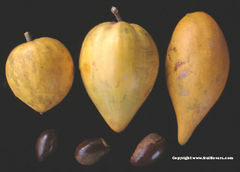Pouteria campechiana
| Pouteria campechiana subsp. var. | ||||||||||||||||||||||||||||||||||||||||||||||||||||||||
|---|---|---|---|---|---|---|---|---|---|---|---|---|---|---|---|---|---|---|---|---|---|---|---|---|---|---|---|---|---|---|---|---|---|---|---|---|---|---|---|---|---|---|---|---|---|---|---|---|---|---|---|---|---|---|---|---|

|
|
| ||||||||||||||||||||||||||||||||||||||||||||||||||||||
| ||||||||||||||||||||||||||||||||||||||||||||||||||||||||
The Canistel (Pouteria campechiana) is an evergreen tree native to southern Mexico and Central America. It is cultivated in other countries, such as Brazil, Taiwan, and Vietnam. Its binomial name is derived from the Mexican town of Campeche, where it is native. It is sometimes (wrongly) referred to as Lucuma campechiana.
The canistel grows up to 10 m high, and produces orange-yellow fruits, up to 7 cm long, which are edible raw. Canistel flesh is sweet, with a texture often compared to that of a cooked egg yolk, hence its colloquial name of "eggfruit." It is closely related to the Mamey sapote and abiu.
| Standard Cyclopedia of Horticulture |
|---|
|
Lucuma nervosa, A. DC. (L. Rivicoa var. angustifolia, Miq.). Ti-Es. Egg-Fruit. Canistel. Fig. 2214. A small tree, 10-25 ft. high, with spreading branches: lvs. oblong- obovate to oblanceolate, 4-8 in. long, glabrous, bright green, acute: calyx-lobes 5, the inner ones rounded at the apex: corolla whitish, lobes ovate; style columnar, stigma slightly dilated; ovary 5-celled: fr. globose to ovoid, orange-yellow, 2-4 in. long, usually 2- or 3-seeded. A native of N. S. Amer., but cult, in other parts of Trop. Amer., naturalized on some of the Florida keys.
|
Cultivation
Propagation
Pests and diseases
Species
Gallery
If you have a photo of this plant, please upload it! Plus, there may be other photos available for you to add.
-
photo 1
-
photo 2
-
photo 3
References
- Standard Cyclopedia of Horticulture, by L. H. Bailey, MacMillan Co., 1963
External links
- w:Pouteria campechiana. Some of the material on this page may be from Wikipedia, under the Creative Commons license.
- Pouteria campechiana QR Code (Size 50, 100, 200, 500)
